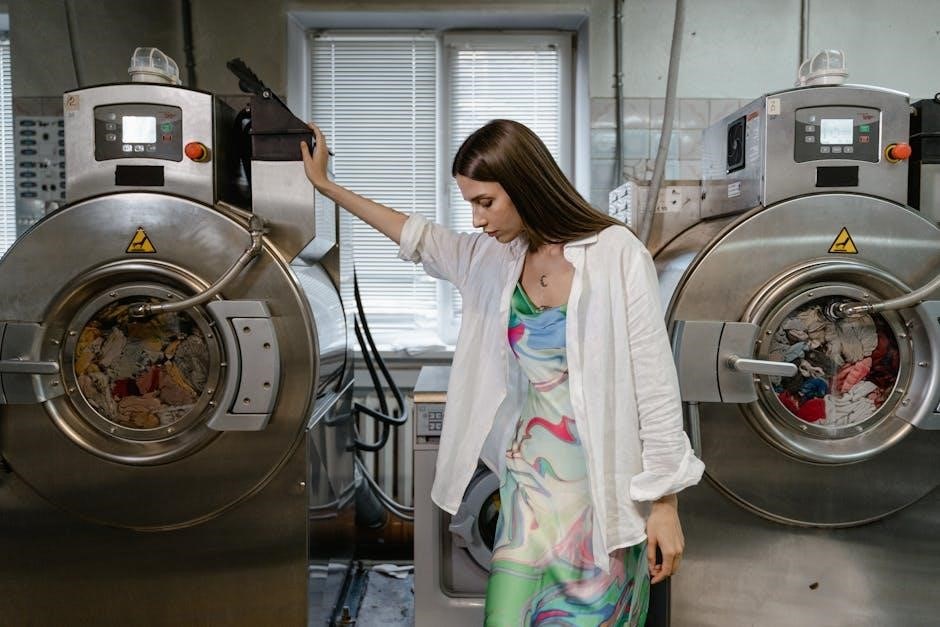bosch washing machine troubleshooting guide
Bosch washing machines are renowned for their quality and innovative features, but like any appliance, they can encounter issues. This guide helps you diagnose and resolve common problems, ensuring optimal performance and longevity.

Common Issues in Bosch Washing Machines
Bosch washing machines often face issues like error codes (e.g., E:18), leakages, excessive noise, and mid-cycle stopping. These problems typically stem from faulty pumps, imbalanced loads, or blockages in drainage systems.
Understanding Error Codes (E:18, E:27, etc.)
Error codes on Bosch washing machines, such as E:18 or E:27, indicate specific issues that need attention. E:18 often relates to drainage problems, while E:27 may signal a heating malfunction. These codes are designed to help users identify the root cause quickly. For instance, E:18 might mean the drain pump is clogged or malfunctioning, requiring you to check the filter or hoses for blockages. Similarly, E:27 could indicate a faulty heater or temperature sensor, which may need professional repair. Understanding these codes is crucial for effective troubleshooting, as they guide you to the exact component that needs attention. By addressing these issues promptly, you can prevent further damage and ensure your machine runs efficiently. Always consult the user manual or Bosch support for accurate interpretations, as codes can vary slightly by model. Regular maintenance, such as cleaning filters and checking connections, can also help avoid these errors altogether.
Addressing Leakages and Water Damage
Leaks in Bosch washing machines can lead to significant inconvenience and potential property damage if not addressed promptly. Common causes include faulty drain pumps, worn door seals, or clogged filters. To identify the source, inspect the machine’s base and hoses for visible water trails. If the leak occurs during the wash cycle, it may indicate a malfunctioning gasket or detergent drawer issue. Regular maintenance, such as cleaning the filter and checking for blockages, can prevent many of these problems. For persistent leaks, running a diagnostic cycle or consulting the user manual can help pinpoint the issue. In severe cases, professional repair may be necessary to avoid further damage. Addressing leaks promptly ensures your Bosch washing machine continues to function efficiently and prevents costly water damage repairs.

Troubleshooting Steps for Bosch Washing Machines
Identify error codes, inspect filters, and restart the machine. Check for blockages, ensure proper installation, and verify detergent usage. If issues persist, consult the manual or contact a professional for assistance.
Diagnosing Mid-Cycle Stopping (E:18 Error)

The E:18 error typically indicates a drainage issue, causing the machine to stop mid-cycle. Begin by checking the drain pump filter for blockages, such as lint or coins. Ensure the drain hose is kink-free and properly connected. If the filter is clean and the hose is clear, the issue may lie within the pump itself. In some cases, the pump might be faulty and require replacement. Additionally, verify that the water supply faucets are fully open, as inadequate water flow can trigger this error. Running a diagnostic cycle or resetting the machine might also resolve the problem. If these steps fail, professional assistance may be necessary to inspect internal components.
Identifying and Fixing Noise and Vibration Issues
Noise and vibration problems in Bosch washing machines can often be traced to imbalanced loads, faulty components, or improper installation. Start by ensuring the machine is level—adjust the feet if necessary. An uneven surface can cause excessive vibration and noise during cycles. Next, check for loose items inside the drum, as they can create loud clattering sounds. If the issue persists, inspect the drain pump and hoses for blockages, as obstructions can lead to unusual noises. In some cases, worn-out bearings or a malfunctioning drum may be the culprit, requiring professional repair or replacement. Running an empty cycle with a gentle detergent can also help identify if the noise is related to internal components. Addressing these issues promptly will restore your machine’s quiet operation and prevent further damage.

Maintenance Tips for Optimal Performance
Regular maintenance is crucial for extending the life of your Bosch washing machine. Clean the filters and gasket, run diagnostic cycles, and leave the door open after use to prevent mold and mildew buildup.
Regular Cleaning and Filter Maintenance
Regular cleaning and filter maintenance are essential for ensuring your Bosch washing machine operates efficiently and effectively. Over time, debris, detergent residue, and lint can accumulate, potentially leading to poor performance or malfunctions. Start by cleaning the filter, usually located at the bottom or back of the machine, depending on the model. Remove any blockages, such as coins or fabric scraps, and rinse the filter under running water. Additionally, wipe down the gasket and detergent drawer to prevent mold and mildew buildup. Bosch machines often feature a drum cleaning cycle, which runs hot water through the interior to remove bacteria and detergent residue. Running this cycle every 1-2 months is highly recommended. For added freshness, leave the door open after use to allow the interior to dry completely. Regular maintenance not only prevents issues but also extends the lifespan of your machine and ensures optimal cleaning results. Consistency is key to keeping your Bosch washing machine in top condition.
Running Diagnostic Cycles
Running diagnostic cycles is a crucial step in maintaining the health and efficiency of your Bosch washing machine. These cycles are designed to identify and address potential issues before they escalate. Bosch machines often feature a built-in diagnostic mode or specialized cycles, such as the drum cleaning cycle, which helps remove bacteria, mold, and detergent residue. To run a diagnostic cycle, consult your user manual for specific instructions, as the process may vary depending on your model. Generally, you can access diagnostic modes by pressing and holding certain buttons or running a specific sequence of cycles. Regular diagnostics help ensure optimal performance, prevent breakdowns, and maintain hygiene. By incorporating diagnostic cycles into your maintenance routine, you can address minor problems early and extend the lifespan of your machine. This proactive approach ensures your Bosch washing machine continues to deliver reliable and efficient service for years to come. Regular checks are key to maintaining peak performance.
Maintaining your Bosch washing machine through regular troubleshooting and maintenance ensures its longevity and efficiency. By addressing common issues like error codes, leakages, and noise promptly, you can prevent minor problems from escalating into costly repairs. Simple practices, such as cleaning filters, running diagnostic cycles, and ensuring proper installation, play a significant role in preserving your machine’s performance. Bosch machines are known for their durability and innovative features, but consistent care is essential to maximize their lifespan. Troubleshooting guides and user manuals provide valuable insights, helping you identify and resolve issues effectively. By staying proactive and following these tips, you can enjoy a reliable and efficient laundry experience for years to come. Remember, regular maintenance and timely interventions are key to keeping your Bosch washing machine in optimal condition.
